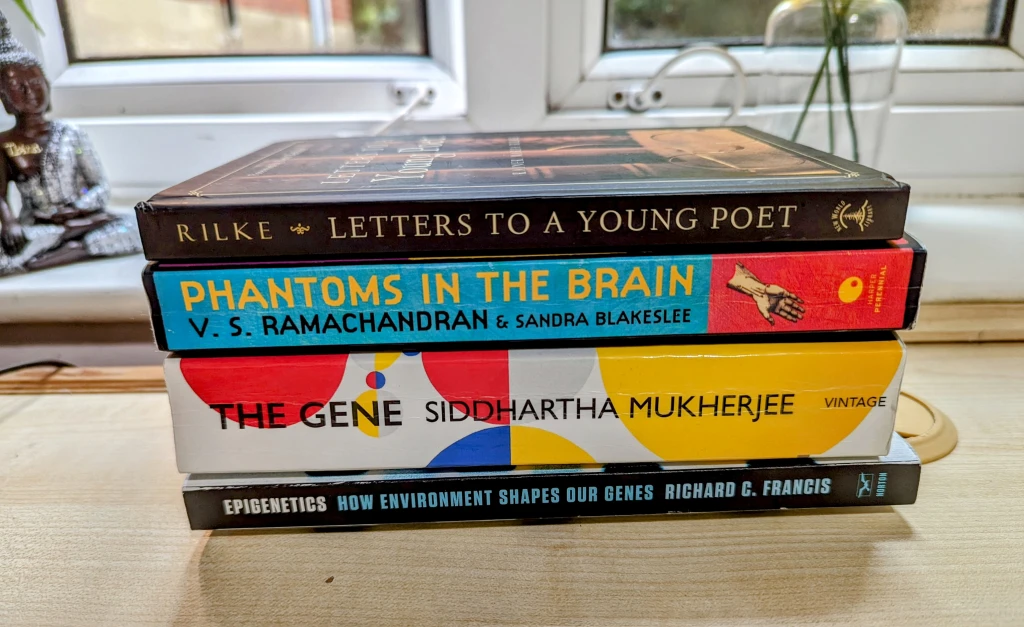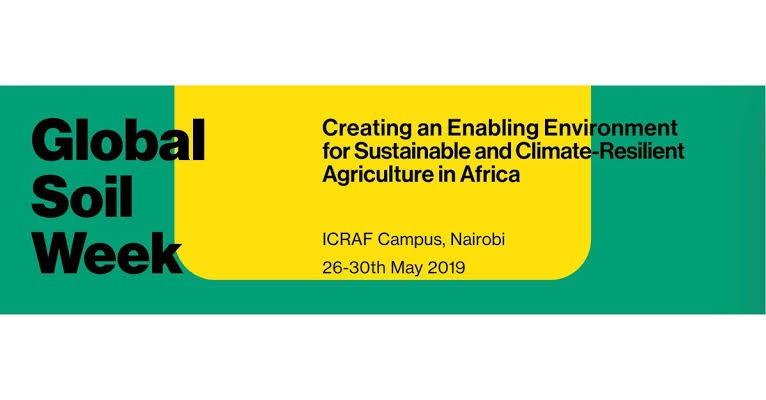In September 2023, my reading took me through the intricate corridors of human creativity, the profound insights from research in genes to the fascinating mysteries of the brain. My four companions in this literary journey were “Letters to a Young Poet” by Rainer Maria Rilke, “Epigenetics: How the Environment Shapes Our Genes” by Richard C. Francis, “The Gene” by Siddhartha Mukherjee, and “Phantoms in the Brain” by V.S. Ramachandran and Sandra Blakeslee. In this article, I explore the essence of each of these books and the insights they offer.
- “Letters to a Young Poet” by Rainer Maria Rilke
This is a collection of ten letters written by Rilke between 1903 and 1908 in response to a young and aspiring poet named Franz Xaver Kappus. The letters are imbued with wisdom, guidance, and profound insights applicable to anyone embarking a on creative, artistic, or introspective journey.
One of the key themes in the book is the idea of solitude and inner exploration. Rilke argues that before aspiring artists could connect with the outside world through their works, they had to first connect with their inner selves. Solitude, then is not a lonely or desolate state of being but a fertile ground for personal and artistic growth as well as a source of creative energy.
Rilke emphasizes the importance of authenticity in creative endeavours. He asserts that true art emerges from the depths of one’s soul, from a place of sincerity and genuine feeling. He encourages Kappus to avoid imitating others and instead cultivate a unique and authentic voice, a message that is significant in a world inundated with imitation and conformity.
Rilke also advocates the beauty of living with questions and uncertainties advising Kappus “to have patience with everything unresolved in your heart” and to “learn to love the questions themselves” and “perhaps you will gradually, without even noticing it, find yourself experiencing the answer, some distant day.” In a world where answers are sought with urgency, Rilke argues that questions are not obstacles to be overcome but pathways to deeper understanding and creativity.
“Letters to a Young Poet” is a timeless classic that continues to inspire and guide readers on their personal and creative journeys offering universal lessons applicable not only to creatives but also to anyone in pursuit of their passions or personal growth.
2. “Epigenetics: How the Environment Shapes Our Genes” by Richard C. Francis
“Epigenetics” by Richard C. Francis delves into the fascinating world of genetics and the role that the environment plays in shaping our genes explaining how external factors such as diet, stress, and toxins can influence the activity of genes (gene expression). Epigenetics is the long-term alteration of DNA without changing its sequence. Francis highlights how our genes respond and adapt to the environment and pass on these changes to future generations.
The book starts with the pivotal role of epigenetics in early human development or embryogenesis with insights from the Dutch Famine Cohort Study that started in 1945 and continues to this day. One of the key insights from the study is the likelihood of obesity, type 2 diabetes, high blood pressure, cardiovascular diseases, mental disorders, and lung or kidney problems depending on the trimester the exposure of the foetus to the famine happened. Hence, children exposed to the famine through their mother’s wombs were more prone to certain diseases than those not exposed to the famine without having to inherit the disease-causing genes from their mothers.
Amid the cautionary tales, the book also imparts a sense of optimism. Francis elucidates how positive lifestyle changes, such as a balanced diet, exercise, and stress reduction, can reverse harmful epigenetic modifications, promoting health and well-being. This message of empowerment resonates with readers, as it emphasizes the agency individuals have in shaping their own epigenetic destiny.
3. “The Gene” by Siddhartha Mukherjee
Siddhartha Mukherjee’s “The Gene” is an awe-inspiring odyssey through the annals of genetics. The book traces the history of our understanding of heredity starting from the discovery of the gene by the Moravian monk Gregor Mendel, widely considered the father of modern genetics through his groundbreaking work with pea plants in 1856 to the latest advances in gene editing. Mukherjee, a cancer physician and researcher, a stem cell biologist, a cancer geneticist, and an assistant professor of medicine at Columbia University, weaves together the history, the science, and the ethical dimensions of the gene, unravelling its profound impact on our lives. He narrates the history of genetics through human stories – including his family’s struggles with mental illness, bringing genetics out of the laboratory and into our everyday lives, making it relatable and engrossing to readers of all backgrounds.
Mukherjee’s exploration of the gene also dives into the complexities of heredity and inheritance, explaining the role of genes in determining our physical and behavioural traits and hence contributing to the debate of nature versus nurture. He compellingly presents the dynamic interplay between genes and the environment, shedding light on how the two interact to shape who we are.
A gifted storyteller, Mukherjee makes you ‘feel’ the tribulations of the pioneers in the field. Personally, I sympathized with Rosa Franklin over her exclusion in the 1962 Nobel Prize in Medicine won by Watson, Crick, and Wilkins for discovering the double-helical structure of the DNA using her lab images. While visiting Cambridge, a few months ago, I passed by the Eagle Pub where Watson and Crick were regulars and celebrated ‘their’ discovery and noted that someone had scratched the plaque outside to add Franklin’s name.

The book also narrates the ethical questions through the history of genetic research, starting with Galton (Darwin’s cousin), who (mis)thought that a better human race could be produced by regulating marriage and creation and is credited with coining the term eugenics in the 1860s. This opened the way for American eugenics to enact laws to imprison and later sterilize the ‘feebleminded’, a vague term for anyone whose behaviour, appearance, choices, and desires fell outside the norm in the 1920s – told through the story of Buck v. Priddy and Buck v. Bell and finally the Nazi eugenics concentration camps and outright murder of Jews in the 1930s who they considered inferior.
“The Gene” not only educates us about the history of genetic research but also raises ethical and philosophical questions about the power and responsibility that come with a newfound ability to manipulate it. For instance, what is the place of selective abortion after genetic testing in utero (amniocentesis)? What would be the boundaries of human genetic enhancement that wouldn’t cross boundaries? Whose metrics will be used? Is there such a thing as normalcy vs disease or a misfit in the environment when it comes to certain disorders?
Yet genetic research has contributed to advances in medicine such as the discovery of CRISPR-Cas9, a revolutionary gene-editing tool. He showcases the potential of this technology in treating genetic diseases and highlights the ethical concerns that accompany such power.
This is one book I enjoyed and as I turned the last of the 500 pages, I couldn’t help but appreciate the beauty and complexity of genetics and question my career choice!
4. “Phantoms in the Brain” by V.S. Ramachandran and Sandra Blakeslee
“Phantoms in the Brain” is a fascinating journey into the enigmatic realm of the human brain. Written by neuroscientist V.S. Ramachandran and science writer Sandra Blakeslee, the book explores the intricacies of the human brain and the unusual conditions that can manifest within it.
The book sheds light on bizarre neurological conditions, such as phantom limbs, in which amputees continue to feel sensations and even pain in limbs that no longer exist. It delves into the nature of consciousness and the brain’s remarkable ability to adapt and rewire itself inviting the reader to consider the profound implications of brain plasticity and the way our brains construct our perception of reality.
“Phantoms in the Brain” also addresses the philosophical implications of these neurological phenomena, challenging our understanding of self and identity. It underscores the profound connection between our physical brains and our subjective experiences, making us question the nature of reality itself.
Conclusion
The books I encountered in September 2023 offered a diverse and profound exploration of human nature, genetics, and the enigmatic world of the brain. “Letters to a Young Poet” inspired us to tap into our innermost selves for authentic self-expression, “Epigenetics” illuminated the intricate interplay between genetics and environment, “The Gene” delved into the history and implications of our genetic knowledge, and “Phantoms in the Brain” explored the profound mysteries of consciousness and perception. These reads serve as a testament to the enduring power of literature and science in shaping our understanding of the world and our place within it.





Leave a comment